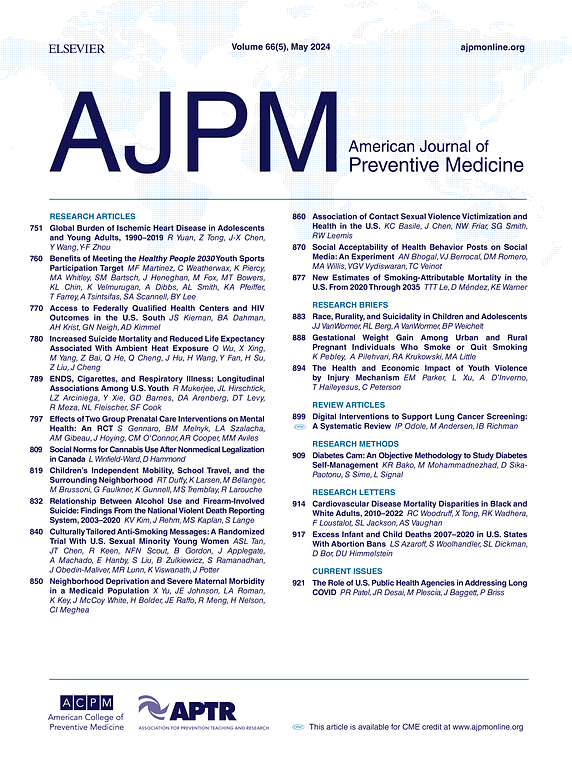不仅仅是肤浅的:拥抱美学家在促进健康和社区合作中的作用。
IF 4.3
2区 医学
Q1 MEDICINE, GENERAL & INTERNAL
引用次数: 0
摘要
简介:阴毛脱毛(PHR)是一种常见的做法,许多人从护肤专业人士或美容师那里寻求脱毛。美容师扮演着独特的角色,他们通常与客户有着深厚的信任关系和良好的关系,因此他们可以作为值得信赖的皮肤和美容专业知识提供者,同时也是健康促进伙伴/促进者。本研究的目的是探讨美容师参与客户皮肤上7种潜在健康相关症状的频率,并检查美容师参与健康讨论的舒适度,有关这些健康问题的知识,以及更正式地参与客户健康的兴趣。方法:于2023年3月- 8月进行横断面调查。潜在的参与者是通过有目的的抽样(脱毛/脱毛沙龙)来确定的,辅以滚雪球抽样,在11个预先选择的美国大都市地区。N=359名提供PHR服务的美容师完成了在线素质调查(97.5%为女性;白人36.2%,黑人24.0%,西班牙裔20.1%)。结果:被关注、讨论和提及最多的问题是一般皮肤健康(90.3%被关注,82.2%被讨论/提及),其次是性传播感染(STIs;39.2%注意到,36%讨论,26%提及)。更多的受访者承认讨论皮肤癌(26.6%),而注意到皮肤癌(19.8%)。大多数样本表明,在改善其客户健康方面可接受程度很高,72.7%的人表示支持在这方面与卫生专业人员合作。结论:这是一个主要的机会,以帮助促进美容师直接改善健康和福祉,超越他们的客户的皮肤。本文章由计算机程序翻译,如有差异,请以英文原文为准。
More Than Skin Deep: Embracing the Role of Estheticians for Health Promotion and Community Collaboration
Introduction
Pubic hair removal is a common practice, and many people seek pubic hair removal from skincare professionals or estheticians. Estheticians play a unique role in which they often have deep, trusting relationships and a well-established rapport with their clientele, whereby they could serve not only as trusted providers of skin and beauty expertise but also as health promotion partners/facilitators. This study aimed to explore the frequency of estheticians’ involvement in 7 potentially concerning health-related symptoms on their clients’ skin and examine estheticians’ comfort by engaging in discussions about health, knowledge regarding these health issues, and interest in being more formally involved in their clients’ health.
Methods
A cross-sectional survey was conducted between March and August, 2023. Potential participants were identified using purposive sampling of Yelp listings (of hair removal/waxing salons), supplemented by snowball sampling, in 11 preselected U.S. metropolitan areas. A total of 359 estheticians who provided pubic hair removal services completed an online Qualtrics survey (97.5% women, 36.2% White, 24.0% Black, and 20.1% Hispanic).
Results
The most noticed, discussed, and referred issue among the sample was general skin health (90.3% noticed, 82.2% discussed/referred), followed by sexually transmitted infections (39.2% noticed, 36% discussed, and 26% referred). More respondents acknowledged discussing (26.6%) rather than noticing (19.8%) skin cancers. Most participants indicated high acceptance regarding improving the health of their clientele, and 72.7% expressed support for partnering with health professionals in such efforts.
Conclusions
This is a prime opportunity to aid in the facilitation of estheticians directly improving health and well-being beyond the skin of their clients.
求助全文
通过发布文献求助,成功后即可免费获取论文全文。
去求助
来源期刊

American Journal of Preventive Medicine
医学-公共卫生、环境卫生与职业卫生
CiteScore
8.60
自引率
1.80%
发文量
395
审稿时长
32 days
期刊介绍:
The American Journal of Preventive Medicine is the official journal of the American College of Preventive Medicine and the Association for Prevention Teaching and Research. It publishes articles in the areas of prevention research, teaching, practice and policy. Original research is published on interventions aimed at the prevention of chronic and acute disease and the promotion of individual and community health.
Of particular emphasis are papers that address the primary and secondary prevention of important clinical, behavioral and public health issues such as injury and violence, infectious disease, women''s health, smoking, sedentary behaviors and physical activity, nutrition, diabetes, obesity, and substance use disorders. Papers also address educational initiatives aimed at improving the ability of health professionals to provide effective clinical prevention and public health services. Papers on health services research pertinent to prevention and public health are also published. The journal also publishes official policy statements from the two co-sponsoring organizations, review articles, media reviews, and editorials. Finally, the journal periodically publishes supplements and special theme issues devoted to areas of current interest to the prevention community.
 求助内容:
求助内容: 应助结果提醒方式:
应助结果提醒方式:


